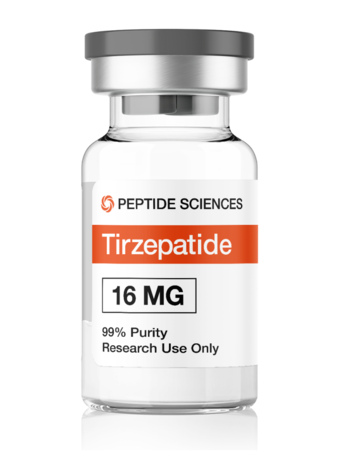Tirzepatide is a synthetic derivative of gastric inhibitory polypeptide (GIP), which also has the simultaneous functionality of glucagon-like peptide-1 (GLP-1). This combination allows Tirzepatide to lower the level of glucose in the blood, increase sensitivity to insulin, increase the feeling of satiety and accelerate weight loss. Tirzepatide was developed to fight type 2 diabetes, but it has also been shown to protect the cardiovascular system and act as a powerful weight-loss agent.
Tirzepatid can be bought in our online store
Tirzepatid — It is a synthetic analog of gastric inhibitory polypeptide (GIP), which was developed due to its ability to stimulate insulin release and thus treats both type 2 diabetes and non-alcoholic fatty liver disease. The relatively large tirzepatide, consisting of 39 amino acids, stimulates the release of insulin from the pancreas by binding to GIP and GLP-1 (glucagon-like peptide-1) receptors. With longer administration, tirzepatide also increases the level of adiponectin by as much as 26%. Studies show that Tirzepatide reduces hunger, lowers insulin levels, and increases insulin sensitivity. Combined, these effects lead to a significant weight loss of 11 kg (25 lbs), improved glucose tolerance, reduced adipose tissue, and reduced cardiovascular risk.
What does Tirzepatid
Simply put, Tirzepatid increases the release of insulin from the pancreas, which leads to improved glucose control. Studies show that in people with type 2 diabetes, tirzepatide reduces hemoglobin A1c (HbA1c) by 2.4% after six months. The peptide also promotes weight loss, demonstrating a dose-dependent relationship and helping people lose up to 11 kg (25 pounds) in six months.
breakdown of beta cells of the pancreas, cells that produce and secrete insulin. Studies show that tirzepatide can actually make beta cells more efficient in insulin processing, which leads not only to an increase in the level of insulin in the bloodstream, but also to a decrease in the load on the beta cells themselves. This, in turn, can help slow down the progression of type 2 diabetes.
However, studies show that tirzepatide does not just accidentally increase insulin levels. It seems that this happens only in response to an increase in the level of glucose in the blood. During fasting, Tirzepatide actually lowers insulin levels and, thus, over time helps to increase insulin sensitivity. It also lowers fasting glucagon levels, which are believed to exacerbate hyperglycemia by interfering with glucose metabolism in the liver. Overall, these changes largely explain why tirzepatide has a profound effect on glucose levels and, ultimately, on HbA1c
How Tirsepatid works
Tirzepatid is a dual agonist of gastric inhibitory polypeptide receptor and glucagon-like peptide-1 receptor. Action on these receptors, apparently, has a synergistic effect, which makes Tirzepatide more effective than strict GLP-1 agonists, which are already approved for the treatment of type 2 diabetes. The affinity of tirzepatide for the
GIP receptor is higher than its affinity for the GLP-1 receptor.
Gastric inhibitory polypeptide, which is also called glucose-dependent insulinotropic polypeptide, is naturally synthesized in the small intestine. This polypeptide binds to the GIP receptor, inhibiting the secretion of gastric acid and the release of gastrin, while simultaneously stimulating the release of insulin. The latter is the main function of GIP-R and the main reason for the increase in insulin levels after a meal.
Glucagon-like peptide-1 receptors are found on beta cells, as well as in neurons of the brain. Like GIP-R, GLP-1R stimulation stimulates insulin release. Natural agonists include glucagon and GLP1, but it has also been shown to bind nearly a dozen synthetic agonists, including dulaglutide, lithium, and oxyntomodulin.
GLP-1R activation increases both insulin synthesis and insulin release, factors that have made it a desirable target in drug development. In the brain, GLP-1R stimulation reduces appetite.
It seems that the GIP agonism caused by tirzepatide is the reason for the long-term effect of the peptide on weight. GIP appears to directly affect the sensitivity of adipocytes to insulin, which is likely the mechanism by which tirzepatide affects adiponectin levels. In short, Tirzepatide activates HIP receptors in fat cells, which then leads to increased sensitivity to insulin. This, in turn, leads to an increase in the inflammation of adipose tissue, as well as to an increase in the level of adiponectin and the associated benefits. However, this is not the whole picture.
Research shows that the transmission of GIP signals in the central nervous system regulates the feeding centers of the hypothalamus, which leads to a decrease in food consumption and an improvement in glucose processing. This, in turn, leads to a decrease in body weight. Thus, it appears that tirzepatide affects weight through adiponectin signaling directly in adipose tissue and through CNS changes that reduce hunger through GIPR signaling in the brain.
Brief description of Tirzepatide
Tirzepatide is a synthetic derivative of gastric inhibitory polypeptide (GIP), which also has the simultaneous functionality of glucagon-like peptide-1 (GLP-1). This combination allows Tirzepatide to lower the level of glucose in the blood, increase sensitivity to insulin, increase the feeling of satiety and accelerate weight loss. Tirzepatide was developed to fight type 2 diabetes, but it has also been shown to protect the cardiovascular system and act as a powerful weight-loss agent.



